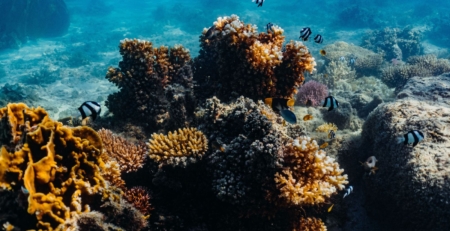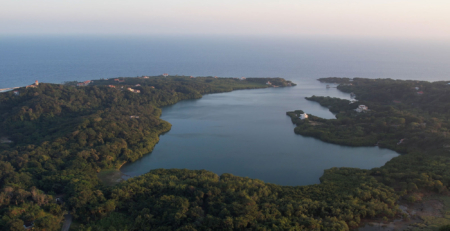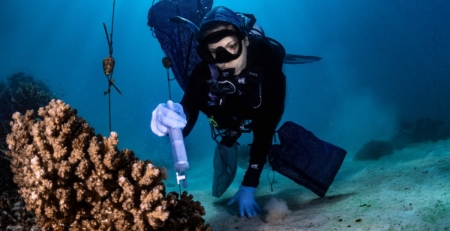Bleaching without witnesses: the history of coral bleaching in South Atlantic reefs
By Thomas Banha
For a long time, Brazilian reefs were overlooked in global coral bleaching assessments. This year, two studies reconstructing the history of coral bleaching in Brazil were published just two days apart. Hopefully, this marks a turning point for our reefs helping to put South Atlantic corals in the spotlight.
Back in March, I published a journal club article discussing a global analysis of coral bleaching that failed to include the South Atlantic. I described in the piece my frustration with that, while highlighting the lack of a database of coral bleaching in Brazil as the probable cause. To my surprise, in the following month, two articles were published detailing the history of bleaching in Brazil, where the great majority of reef-forming corals are found in the South Atlantic. I reached out to MSc. Giovanna Destri, who is currently a PhD Student at the Universidade de São Paulo and lead author of one of the studies, to learn a little more.
The overview
Over the past 40 years, multiple thermal stress events were recorded in the South Atlantic and, unfortunately, they are becoming more intense, longer-lasting, and happening more often. But this did not come as a surprise, as Destri explained “We expected that intensity, duration, and frequency of these episodes would be increasing, following global trends.” This is corroborated by the other work, led by Gabriel Silva. Based on a compilation of three decades of bleaching records in the Southwestern Atlantic (1992-2022), they observed that 80% of these events occurred only after 2010.
However, thermal stress doesn’t always mean bleaching. There are two likely reasons: Brazilian corals may be more heat-resistant, or they simply were not monitored consistently. Destri et al. (2025) suggests that the latter is true, as multiple bleaching episodes were not documented. “What shocked me the most was realizing how many thermal stress events had occurred, without us having access to the possible impacts of these events,” she highlights.
But why did they go unnoticed?
In the journal club article, I argued that we lack a comprehensive, standardized coral bleaching database for Brazil. Destri’s research reinforces that view, stating “Our data indicated several undocumented thermal stress events over the past 40 years. However, we cannot confirm whether bleaching actually occurred because those reef environments were not being monitored during all those years.” Although true, this scenario slightly changes now, as a recent publication filled, at least partially, this gap. Silva’s database of 30 years of bleaching events in Southwestern Atlantic coral communities helps fill part of the historical gap and could serve as a reference for future research and monitoring.
Spatial bias
Additionally, some factors contribute to this inequality in monitoring. First, Brazil is huge, as the Brazilian coast extends through c. 9500 km. Secondly, unlike the Caribbean or Indo-Pacific, Brazil does not have extensive coral reefs. Instead, it has more rocky reefs, which (unfortunately) attract less attention. Brazil has only four main coral reef regions, with Abrolhos being the main one, remaining for decades as the to-go site for coral research. This results in a geographical bias and might explain why many events went unnoticed. “For a long time, the research attention was focused mainly on the reefs of the Abrolhos region, while communities in southeast Brazil, for example, were facing significant thermal anomalies,” highlights Destri.

Figure 1: Coral bleaching on an Acropora branch. Credit: The Ocean Agency / Ocean Image Bank.
Not all reefs are affected equally
The historical reconstruction by Destri’s work evidenced an important thing: some reef sites experienced very few – or even no – thermal stress episodes over the past four decades. While we can look to these areas as an oasis of hope, this must be taken with caution. “That doesn’t mean these environments are heat-resistant, but rather that oceanographic phenomena, like upwelling, may have prevented thermal anomalies from occurring in those places” warns Destri.
What can be done?
This is the million-dollar question: what actions can we take? The main threat to corals is climate change, which is beyond the reach of local actions. However, we cannot stand still and must take action. “I would focus on creating protected areas in regions with significant coral cover that have already faced or are currently facing major thermal stress events,” Destri suggests. This aligns with the idea of protecting corals that are already coping with stress and may be more resilient.
However, creating a protected area does not work if it is not monitored. “To evaluate the effectiveness of these protection measures, we would need ongoing monitoring of thermal anomalies in each area, combined with an in situ observation network for bleaching” emphasizes Destri. Notably, the call for monitoring efforts is also made by Silva’s paper.
Together, these new studies not only shed light on the overlooked history of coral bleaching in the South Atlantic but also provide data for a more informed, equitable, and urgent response to the climate crisis our reefs (and we) are facing. Now, it remains to be seen if they will start to be included in future global analysis.
References
Banha T (2025) Finding inspiration in frustration: lessons from reef science. Nature Reviews Biodiversity, 1, 149. https://doi.org/10.1038/s44358-025-00027-y
Destri G, et al. (2025) The Thermal Stress History of South Atlantic Reefs Reveals Increasing Intensity, Duration, Frequency, and Likely Undocumented Bleaching Episodes. Global Change Biology, 31(4), e70162.
Silva GLX, et al. (2025) Thirty years of coral bleaching in the Southwestern Atlantic Ocean: a historical assessment based on degree heating week indices. Coral Reefs, 1-15.










